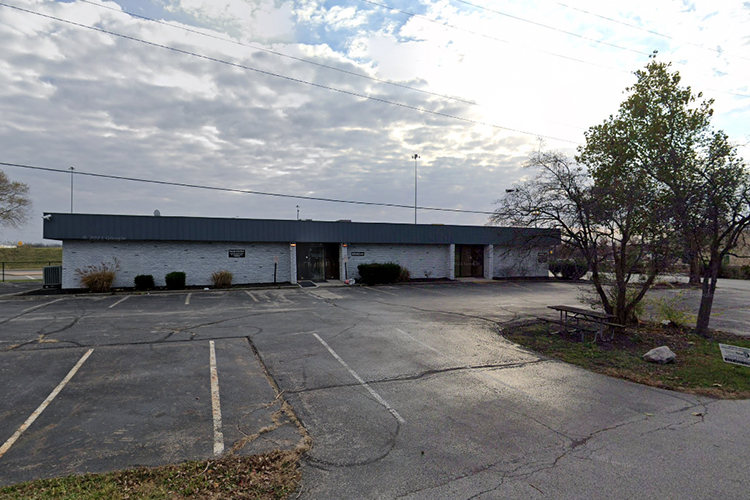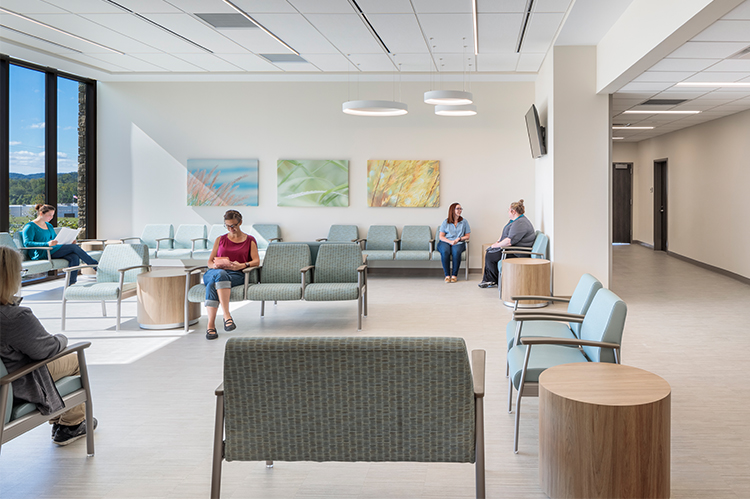With thoughtful planning, architecture can help legitimize addiction as a health disorder that deserves respect and personal dignity. Here are four potentials that may help drive positive societal change.
Note: This article is the second of a series of three focused on substance-use disorder care. Our writer, DesignGroup Project Architect Kristina Bertocchi, offers ideas that will help build societal understanding about the medical nature of addiction treatment. We celebrate and support her work toward a more compassionate care environment. Please also view Part 1.
By Kristina Bertocchi, AIA, NCARB, Project Architect, DesignGroup
Part 1 in the series explored the social stigma that can be attached to addiction and, therefore, addiction treatment centers. As architectural designers, we can contribute to positive change by rethinking our own approach to the design of addiction centers.
There’s a building in my neighborhood. It’s really close. I can see it out my back door, and I drive by it every day.
Last month, I began some new research about treatment facilities for substance use. Then – only then – did I discover that the building just off of my back steps is a substance use disorder care center. It made me think even more about how these buildings fit (or don’t fit) into society as a whole and how architecture might serve as a bridge to bring understanding and compassion for addiction, treatment, and people receiving care.

These buildings are important to our communities. But they largely feel unseen and hidden. Collectively, we can work to evolve the image of addiction centers. I think it’s a good start to consider the following four architectural potentials.
1. Face to the Community
I’ve since learned the building behind my home is a wonderful organization. My unawareness was not a critique of the organization or even of that building. But it serves as inspiration to consider the importance of the face of a building and what it says to the community.
So many questions came to mind. What if the building looked a different way? What if it had some of the components usually seen in more widely known areas of health care? Would it be more seen? More accepted? If the same building started to proactively convey care, collective, and pride to the community, would it be easier for a person to enter that building to receive care? Might such enlightened attitudes lead to a more open conversation when professionals wish to refer a patient into care?
2. Integration in Whole Health
Along with the building’s face to the community, it’s also crucial to consider the integration it could easily share with other physical and mental health services. If there were the same caliber of signage, branding, and wayfinding for substance use care as there is for women’s health, primary care, and oncology, it would alleviate some of the shame that some might feel in receiving care.

Setting aside the stigma of addiction treatment, consider the benefit of designing these facilities to share similarities with other healthcare buildings. If nothing else, it could create the image of a more comprehensive spectrum of patient care – from physical health to mental health to specialty wellness. Consider also that most patients entering addiction care are either referred from primary care or another area of physical care, or perhaps stepped down from an Emergency Department.
3. Consistency and Expectation-Setting
Just about any product or service can be advertised, marketed, or branded. There is an image to portray, feelings to convey, and promises to be kept. As you enter the Starbucks drive-thru line, you have certain expectations that are based on years of experience, messaging, store design, interior experience, and social reinforcement.
Similarly, as people enter the care of a substance use treatment center (or even as you look at that center from your back steps), they will come to that moment with expectations. You don’t plan these expectations. You just feel them automatically. It could be a feeling of uneasiness or relief. Or a jumbled sense of confusion and sadness that stems from the stigma of addiction.
How can we design buildings that generate more positive and accepting feelings about the care provided inside the facility? We can use consistency, quality, and expectation-setting over the long term. Kind of like a Starbucks, but far more life-changing.
4. Community Integration
Starbucks gets another thing right: integration into the community. While you can go to any Starbucks in the country, if you’re an avid customer, you probably have a connection to one that is in your community. If we also visually integrated substance disorder treatment into the community, it would increase its presence and acceptance. It would improve access to care and erode some of the stigma.

How might it feel to receive care in your own community without shame? What might it mean to know that your community is embracing all forms of health care? It just might create a better view from everyone’s back steps.
That may seem like more questions than answers, but that’s where we are presently. The good news is that we’re asking. When addiction care centers can reflect the same face, integration, consistency, and community as other healthcare centers, attitudes will change. Stigmas can fall away. By creating a cohesive whole health system, we can help evolve these care centers into something that is both distinguished and recognizable.

Kristina Bertocchi, AIA, NCARB
Project Architect
As a project architect, Kristina finds purpose in helping the client’s vision become a reality, from early conception to construction. She is dedicated to the healthcare discipline and enjoys working in a field that gives back to the communities she works in. Kristina believes communication is at the core of architecture and that successful communication results in successful projects. She balances her professional work with academic engagement at The Ohio State University, teaching freshman studio to help support the students during their challenging first year.
